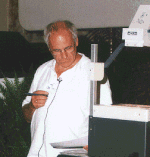 ANALYTICAL FINDINGS IN A SUSPECTED CASE OF TAMPERING WITH A MORPHINE PUMP
ANALYTICAL FINDINGS IN A SUSPECTED CASE OF TAMPERING WITH A MORPHINE PUMP
Bugge A., Morland H., Slordal L.
National Institute of Forensic Toxicology, Lovisenberggata 6, 0456 Oslo, Norway
A terminally ill cancer patient was given morphine (M), 40 mg/day, as pain relief by continuous subcutanous injection by a pump. At two occasions, and both times in connection with visits of the patients daughter, the pump seemed to have delivered bolus doses of morphine. Shortly after the second visit the police was called to investigate. Blood samples were drawn 1.5 hours after the suspected irregular injection and at three additional time points at 45, 105 and 165 minutes later. The serum samples were analysed by GC/MS and showed M levels of 0.21 (60), 0.13 (37), 0.14 (40) and 0.08 (23) µmol/L (mg/mL). The concentrations of morphine-3-glucuronide (M3G) and morphine-6-glucuronide (M6G) were determined by HPLC. The concentrations found for the three first samples were 2.34 (1083), 2.09 (968) and 2.04 (945) for M3G and 0.54 (250), 0.31 (144) and 0.30 (139) µmol/L (µg/mL) for M6G. Subcutaneous administration gives a slow and continuous transfer of the drug to the blood, without a first pass through the liver. The blood levels of morphine, M3G and M6G were in the ranges seen when morphine is used for pain relief treatment. No increase in morphine concentration over the 4 hour period when the samples were collected was seen. Neither was there an increase in the M3G and M6G metabolites together with a concurrent decrease in morphine, which could have been expected after a bolus injection. The analyses could therefore not support the notion of suspected tampering with the morphine injection pump. The patient's daughter, who spent a short period in police custody, has since been awarded a compensation for unlawful arrest to the amount of approx. £ 16,000.
|